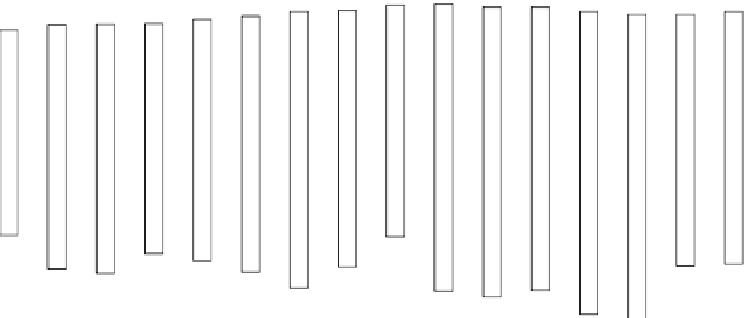Environmental Engineering Reference
In-Depth Information
10.0
8.0
6.0
4.0
2.0
0
-2.0
- 4.0
- 6.0
Land use
Fossil fuels
Residual terrestrial sink
Oceanic uptake
Atmospheric increase
- 8.0
-10.0
1980
1981
1982
1983
1984
1985
1986
1987
1988
1989
1990
1991
1992
1993
1994
1995
Year
Fig. 1.15
Annual variations from 1980 to 1995 in the global atmospheric increase in carbon dioxide
(circle s and black line)
and in carbon released (histograms above the midline) or accumulated (histograms below the midline) by changes to the
burning of fossil fuels, land use, oceanic uptake and an uncertain terrestrial sink (probably related to increased plant
productivity). (From Begon et al., 2006, after Houghton, 2000.)
involving carbon dioxide uptake associated with increased terrestrial productivity
in northern mid-latitude regions (Houghton, 2000).
There is considerable year-to-year variation in the estimates of carbon sources
and sinks, and of increases in the atmosphere (Figure 1.15). Declines in the rate of
increase between 1981 and 1982 followed sharp rises in oil prices, while declines
in 1992 and 1993 followed the collapse of the Soviet Union. In 1997-8 (not shown
in Figure 1.15 but evident, if you look carefully, in Figure 1.14), massive forest fi res
in a small part of the globe (Indonesia) doubled the growth rate of CO
2
in the
atmosphere. The accurate prediction of future changes in carbon emissions is diffi -
cult because so many variables play a role (climatic, political and sociological). And
predictions of consequences for patterns in global temperature and precipitation are
no less straightforward. However, the matter is pressing because we can be sure that
climate change will further complicate all the other environmental issues so far
discussed.
1.3
Toward a
sustainable future?
Can there really be people (ex ploiters) intere sted only in short-term fi nancial gain
and with absolutely no thought for adverse environmental consequences? And can
others (preservationists) be so naive as to argue that nature should be protected
always and everywhere? Human nature is such that we tend to identify more with
one pole than the other, and then to assume that those at the other end are extrem-
ists. Of course there are some fundamentalists, but the vast majority are not so
polarized. Those who take the middle ground appreciate the necessity to produce









































Search WWH ::

Custom Search